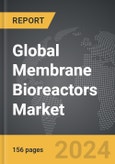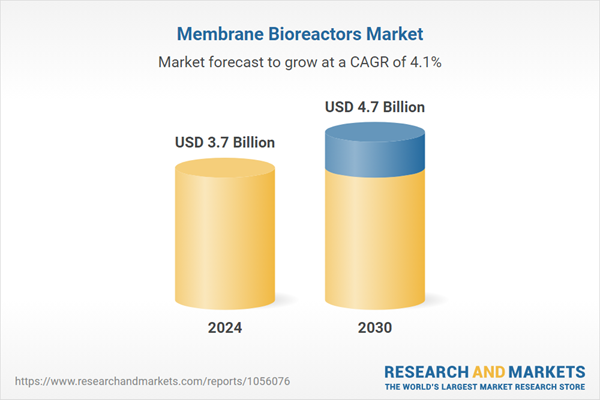The global market for Membrane Bioreactors was valued at US$3.7 Billion in 2024 and is projected to reach US$4.7 Billion by 2030, growing at a CAGR of 4.1% from 2024 to 2030. This comprehensive report provides an in-depth analysis of market trends, drivers, and forecasts, helping you make informed business decisions. The report includes the most recent global tariff developments and what they mean for your business.
The technology behind membrane bioreactors has evolved considerably, making them more reliable and cost-effective. Modern MBR systems feature robust membranes that offer high permeability and are designed to resist fouling, a common challenge where solid particles accumulate on the membrane surface, impeding performance. To mitigate fouling, many MBR systems incorporate advanced cleaning protocols such as air scouring, backwashing, and chemical cleaning. Additionally, innovations in membrane design, including flat-sheet, hollow-fiber, and multi-tube configurations, have enhanced the flexibility and efficiency of MBRs across various wastewater treatment applications. The integration of smart sensors and automated control systems allows for real-time monitoring and optimization of the treatment process. These systems ensure consistent effluent quality and operational efficiency by adjusting parameters based on real-time data, minimizing manual intervention and operational costs.
The growth in the membrane bioreactor market is driven by several factors, including the increasing demand for sustainable wastewater treatment solutions and the implementation of stringent environmental regulations that require higher treatment standards. The rising scarcity of water resources and the need for water reuse in both industrial and municipal settings are significant drivers of MBR adoption. Urbanization and population growth lead to higher volumes of wastewater, necessitating advanced treatment technologies like MBRs to handle the increased load effectively. Furthermore, technological advancements such as enhanced membrane durability and reduced costs make MBRs more accessible and appealing to a broader range of users. Government initiatives and investments in infrastructure development, promoting water conservation and reuse, further bolster the market. The adoption of MBRs in emerging economies, where urban and industrial wastewater management is becoming increasingly critical, is also a key growth factor. As industries strive to improve their sustainability profiles and comply with environmental standards, the demand for efficient and high-performance wastewater treatment systems like membrane bioreactors is expected to rise significantly.
Segments: Application (Municipal, Industrial).
Geographic Regions/Countries: World; United States; Canada; Japan; China; Europe (France; Germany; Italy; United Kingdom; Spain; Russia; and Rest of Europe); Asia-Pacific (Australia; India; South Korea; and Rest of Asia-Pacific); Latin America (Argentina; Brazil; Mexico; and Rest of Latin America); Middle East (Iran; Israel; Saudi Arabia; United Arab Emirates; and Rest of Middle East); and Africa.
The analysts continuously track trade developments worldwide, drawing insights from leading global economists and over 200 industry and policy institutions, including think tanks, trade organizations, and national economic advisory bodies. This intelligence is integrated into forecasting models to provide timely, data-driven analysis of emerging risks and opportunities.
Membrane Bioreactors - Key Trends and Drivers
Membrane Bioreactors (MBRs) are sophisticated wastewater treatment systems that integrate conventional biological treatment processes with membrane filtration technology. They are primarily used to treat sewage and industrial wastewater, producing high-quality effluent suitable for discharge into natural water bodies or for reuse in various applications. MBR systems utilize semi-permeable membranes, often composed of materials like polyvinylidene fluoride (PVDF) or polyethylene, to separate solid and liquid components. This dual-action process involving both biological degradation of contaminants and physical filtration, results in superior treatment efficiency compared to traditional activated sludge systems. MBRs are particularly effective in removing pathogens, organic matter, and nutrients, providing a significant improvement in effluent quality.The technology behind membrane bioreactors has evolved considerably, making them more reliable and cost-effective. Modern MBR systems feature robust membranes that offer high permeability and are designed to resist fouling, a common challenge where solid particles accumulate on the membrane surface, impeding performance. To mitigate fouling, many MBR systems incorporate advanced cleaning protocols such as air scouring, backwashing, and chemical cleaning. Additionally, innovations in membrane design, including flat-sheet, hollow-fiber, and multi-tube configurations, have enhanced the flexibility and efficiency of MBRs across various wastewater treatment applications. The integration of smart sensors and automated control systems allows for real-time monitoring and optimization of the treatment process. These systems ensure consistent effluent quality and operational efficiency by adjusting parameters based on real-time data, minimizing manual intervention and operational costs.
The growth in the membrane bioreactor market is driven by several factors, including the increasing demand for sustainable wastewater treatment solutions and the implementation of stringent environmental regulations that require higher treatment standards. The rising scarcity of water resources and the need for water reuse in both industrial and municipal settings are significant drivers of MBR adoption. Urbanization and population growth lead to higher volumes of wastewater, necessitating advanced treatment technologies like MBRs to handle the increased load effectively. Furthermore, technological advancements such as enhanced membrane durability and reduced costs make MBRs more accessible and appealing to a broader range of users. Government initiatives and investments in infrastructure development, promoting water conservation and reuse, further bolster the market. The adoption of MBRs in emerging economies, where urban and industrial wastewater management is becoming increasingly critical, is also a key growth factor. As industries strive to improve their sustainability profiles and comply with environmental standards, the demand for efficient and high-performance wastewater treatment systems like membrane bioreactors is expected to rise significantly.
Report Scope
The report analyzes the Membrane Bioreactors market, presented in terms of units. The analysis covers the key segments and geographic regions outlined below.Segments: Application (Municipal, Industrial).
Geographic Regions/Countries: World; United States; Canada; Japan; China; Europe (France; Germany; Italy; United Kingdom; Spain; Russia; and Rest of Europe); Asia-Pacific (Australia; India; South Korea; and Rest of Asia-Pacific); Latin America (Argentina; Brazil; Mexico; and Rest of Latin America); Middle East (Iran; Israel; Saudi Arabia; United Arab Emirates; and Rest of Middle East); and Africa.
Key Insights:
- Market Growth: Understand the significant growth trajectory of the Municipal segment, which is expected to reach US$4.0 Billion by 2030 with a CAGR of a 4.3%. The Industrial segment is also set to grow at 3.0% CAGR over the analysis period.
- Regional Analysis: Gain insights into the U.S. market, valued at $982.6 Million in 2024, and China, forecasted to grow at an impressive 7.1% CAGR to reach $995.3 Million by 2030. Discover growth trends in other key regions, including Japan, Canada, Germany, and the Asia-Pacific.
Why You Should Buy This Report:
- Detailed Market Analysis: Access a thorough analysis of the Global Membrane Bioreactors Market, covering all major geographic regions and market segments.
- Competitive Insights: Get an overview of the competitive landscape, including the market presence of major players across different geographies.
- Future Trends and Drivers: Understand the key trends and drivers shaping the future of the Global Membrane Bioreactors Market.
- Actionable Insights: Benefit from actionable insights that can help you identify new revenue opportunities and make strategic business decisions.
Key Questions Answered:
- How is the Global Membrane Bioreactors Market expected to evolve by 2030?
- What are the main drivers and restraints affecting the market?
- Which market segments will grow the most over the forecast period?
- How will market shares for different regions and segments change by 2030?
- Who are the leading players in the market, and what are their prospects?
Report Features:
- Comprehensive Market Data: Independent analysis of annual sales and market forecasts in US$ Million from 2024 to 2030.
- In-Depth Regional Analysis: Detailed insights into key markets, including the U.S., China, Japan, Canada, Europe, Asia-Pacific, Latin America, Middle East, and Africa.
- Company Profiles: Coverage of players such as Asahi Kasei Corporation, Blue Foot Membranes, Chengdu Rosun Disinfection Pharmaceutical Co., Ltd., Cloacina, De.mem Pte., Ltd. and more.
- Complimentary Updates: Receive free report updates for one year to keep you informed of the latest market developments.
Some of the 13 companies featured in this Membrane Bioreactors market report include:
- Asahi Kasei Corporation
- Blue Foot Membranes
- Chengdu Rosun Disinfection Pharmaceutical Co., Ltd.
- Cloacina
- De.mem Pte., Ltd.
- Duoning Biotech
- Envirogen Technologies
- Fibracast Limited
- FilterBoxx Inc., an Ovivo company.
- FRC Systems International
Tariff Impact Analysis: Key Insights for 2025
Global tariff negotiations across 180+ countries are reshaping supply chains, costs, and competitiveness. This report reflects the latest developments as of April 2025 and incorporates forward-looking insights into the market outlook.The analysts continuously track trade developments worldwide, drawing insights from leading global economists and over 200 industry and policy institutions, including think tanks, trade organizations, and national economic advisory bodies. This intelligence is integrated into forecasting models to provide timely, data-driven analysis of emerging risks and opportunities.
What’s Included in This Edition:
- Tariff-adjusted market forecasts by region and segment
- Analysis of cost and supply chain implications by sourcing and trade exposure
- Strategic insights into geographic shifts
Buyers receive a free July 2025 update with:
- Finalized tariff impacts and new trade agreement effects
- Updated projections reflecting global sourcing and cost shifts
- Expanded country-specific coverage across the industry
Table of Contents
I. METHODOLOGYII. EXECUTIVE SUMMARY2. FOCUS ON SELECT PLAYERSIII. MARKET ANALYSISIV. COMPETITION
1. MARKET OVERVIEW
3. MARKET TRENDS & DRIVERS
4. GLOBAL MARKET PERSPECTIVE
UNITED STATES
CANADA
JAPAN
CHINA
EUROPE
FRANCE
GERMANY
ITALY
UNITED KINGDOM
SPAIN
RUSSIA
REST OF EUROPE
ASIA-PACIFIC
AUSTRALIA
INDIA
SOUTH KOREA
REST OF ASIA-PACIFIC
LATIN AMERICA
ARGENTINA
BRAZIL
MEXICO
REST OF LATIN AMERICA
MIDDLE EAST
IRAN
ISRAEL
SAUDI ARABIA
UNITED ARAB EMIRATES
REST OF MIDDLE EAST
AFRICA
Companies Mentioned (Partial List)
A selection of companies mentioned in this report includes, but is not limited to:
- Asahi Kasei Corporation
- Blue Foot Membranes
- Chengdu Rosun Disinfection Pharmaceutical Co., Ltd.
- Cloacina
- De.mem Pte., Ltd.
- Duoning Biotech
- Envirogen Technologies
- Fibracast Limited
- FilterBoxx Inc., an Ovivo company.
- FRC Systems International
Table Information
| Report Attribute | Details |
|---|---|
| No. of Pages | 156 |
| Published | April 2025 |
| Forecast Period | 2024 - 2030 |
| Estimated Market Value ( USD | $ 3.7 Billion |
| Forecasted Market Value ( USD | $ 4.7 Billion |
| Compound Annual Growth Rate | 4.1% |
| Regions Covered | Global |









